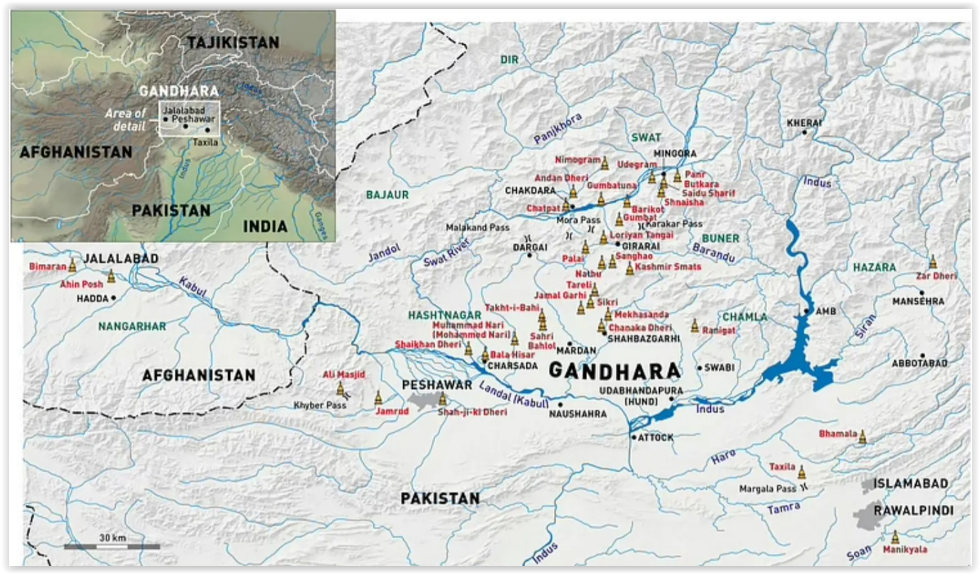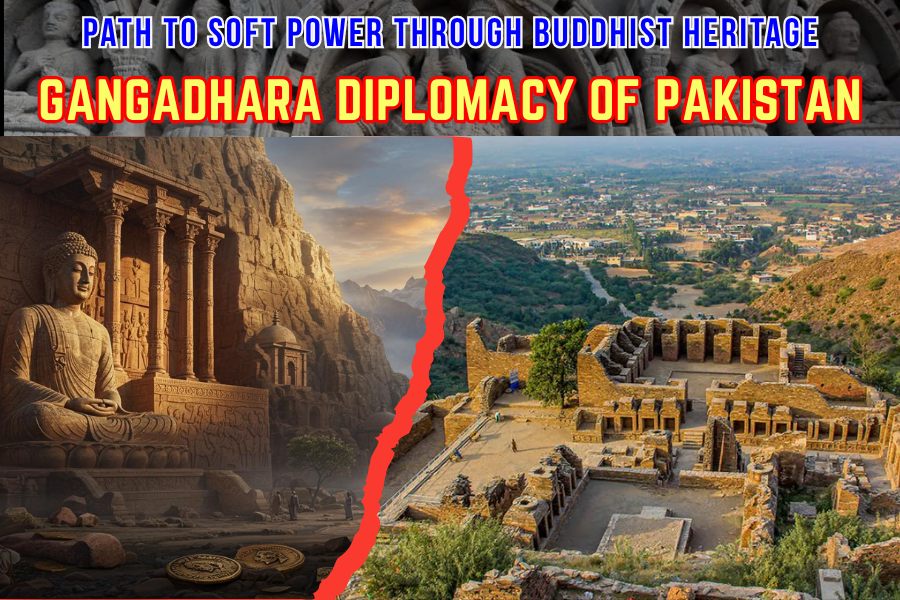(By Khalid Masood)
I. Introduction
In an era where nations leverage cultural heritage as a tool of soft power, Pakistan stands poised to harness its ancient Gandhāra civilization—a cradle of Buddhist philosophy, art, and scholarship—as a cornerstone of its diplomatic strategy. Termed Gangadhara Diplomacy, this initiative seeks to revive Pakistan’s Buddhist heritage, centred in sacred sites like Taxila, Swat, Takht-i-Bahi, Dharmarajika Stupa, Butkara Stupa, and Jaulian Monastery, to foster spiritual connectivity, economic growth, and regional stability. With over 500 million Buddhists worldwide, predominantly in nations like China, Japan, Thailand, South Korea, Nepal, and Sri Lanka—countries with historically warm ties to Pakistan—this heritage offers a unique opportunity to counter negative narratives, including those amplified by India’s geopolitical propaganda and Indus Waters Treaty suspension in April 2025. By promoting Buddhist tourism and aligning with the China-Pakistan Economic Corridor (CPEC), Pakistan can reposition itself as a beacon of peace and cultural harmony in 2025, leveraging its ancient legacy to build bridges across Asia and earn goodwill and respect of many Asian nations.
II. Understanding Gandhāra: A Lost Spiritual Heartland
The Gandhāra civilization, flourishing from the 6th century BCE to the 11th century CE in modern-day Khyber Pakhtunkhwa and Punjab, was a global epicentre of Buddhist thought, art, and education. Centred in Taxila, Swat, and Peshawar, it produced the world’s first Buddha sculptures, blending Greco-Roman and Indian aesthetics, and hosted Taxila University, a renowned centre of learning that attracted scholars like Xuanzang from China. Sacred sites such as the Dharmarajika Stupa, believed to house Buddha’s relics, Takht-i-Bahi, a UNESCO World Heritage Site, and Butkara Stupa in Swat were pivotal in spreading Buddhist teachings to Central, East, and Southeast Asia. The Jaulian Monastery, with its intricate stucco reliefs, exemplifies Gandhāra’s artistic legacy. Despite their historical significance, these sites remain underutilized due to inadequate infrastructure, limited global promotion, and lingering security concerns. Reviving this heritage through Gangadhara Diplomacy can unlock Pakistan’s soft power, countering India’s geopolitical propaganda and supporting CPEC security.

III. The Global Boom in Buddhist Tourism
Buddhist tourism has become a multibillion-dollar industry, with countries like India, Nepal, Thailand, and Japan capitalizing on their Buddhist heritage. India’s Buddhist Circuit, linking Bodh Gaya, Sarnath, and Kushinagar, generates over $2 billion annually, attracting 2 million pilgrims. Nepal’s Lumbini, the Buddha’s birthplace, draws 1.5 million visitors yearly, supported by infrastructure investments and streamlined visas. Thailand’s Visakha Bucha festival and Japan’s Hana Matsuri leverage digital platforms like mobile apps and YouTube documentaries to promote sacred sites. Sri Lanka’s Anuradhapura and Polonnaruwa, enhanced by government portals, contribute significantly to its economy. In contrast, Pakistan’s Gandhāra sites, despite their historical primacy, attract fewer than 50,000 international visitors annually due to poor connectivity, limited marketing, and outdated facilities. Gangadhara Diplomacy aims to transform Pakistan into a premier pilgrimage destination, rivaling India’s circuit and boosting economic growth.
IV. Gangadhara Diplomacy: Strategic Vision
Gangadhara Diplomacy envisions a multifaceted strategy to harness Pakistan’s Buddhist heritage for soft power and economic benefits:
- Gandhāra Corridor: Develop air and rail links from Islamabad to Buddhist-majority capitals like Bangkok, Tokyo, and Kathmandu, with pilgrimage routes connecting Taxila, Swat, and Takht-i-Bahi. Upgrading Peshawar and Islamabad airports and integrating with CPEC infrastructure can enhance access.
- Gandhāra Cultural Alliance: Collaborate with China, Japan, South Korea, Thailand, Nepal, and Sri Lanka for joint archaeological missions, site restoration, and cultural exchanges, leveraging shared Buddhist heritage.
- Soft Power Rebranding: Promote Pakistan as a land of peace, spirituality, and cultural diversity, countering India’s geopolitical propaganda, including the Indus Waters Treaty suspension, which threatens Pakistan’s water security.
- Economic Opportunity: Expand Buddhist tourism to generate foreign exchange, create jobs, and support CPEC security by linking heritage sites to economic corridors, enhancing Pakistan’s global image.
This vision aligns with global trends in cultural diplomacy, positioning Pakistan as a key player in Asia’s spiritual landscape.
V. Geopolitical Relevance: China and the Belt & Road Initiative
China, with 250 million Buddhists, has woven Buddhist heritage into its Belt & Road Initiative (BRI), promoting sites like Dunhuang and Yungang Grottoes. Pakistan can align Gangadhara Diplomacy with CPEC, a flagship BRI project, by:
- Joint Archaeological Missions: Partner with China’s State Administration of Cultural Heritage to restore Gandhāra sites, drawing on China’s expertise at Angkor Wat.
- Heritage Corridors: Develop pilgrimage routes along CPEC highways, linking Taxila to Diamer-Bhasha Dam, enhancing economic and cultural connectivity.
- International Conferences: Host Buddhist forums in Peshawar and Swat, inviting Chinese, Korean, and Thai scholars to highlight Pakistan’s role in Buddhist history.
This synergy strengthens China-Pakistan ties, counters India’s regional dominance, and positions Pakistan as a vital node in the pan-Asian Buddhist network, bolstering CPEC security against asymmetric warfare.
VI. Regional Competition: India’s Buddhist Circuit vs. Pakistan’s Gandhāra Corridor
India has dominated Buddhist tourism through its Buddhist Circuit, backed by a $200 million investment and events like the 2023 Global Buddhist Summit in New Delhi. Sites like Bodh Gaya and Sarnath attract 2 million pilgrims annually, supported by e-visas and digital campaigns. Pakistan, as the birthplace of Gandhāra art and Taxila’s scholarly legacy, holds a competitive edge but lags in infrastructure. To rival India, Pakistan must:
- Upgrade Heritage Sites: Restore Taxila, Takht-i-Bahi, and Butkara Stupa to international standards, with climate-controlled museums and visitor centres.
- Facilitate Pilgrim Visas: Introduce e-visas for Buddhist-majority countries, streamlining access for Thai, Japanese, and Sri Lankan pilgrims.
- Establish a Buddhist Tourism Authority: Coordinate infrastructure, marketing, and security for a seamless pilgrimage experience.
- Secure Funding: Partner with UNESCO and the World Bank for site preservation, as seen in Nepal’s Lumbini Development Trust.
These steps can establish the Gandhāra Corridor as a global pilgrimage hub, countering India’s monopoly and enhancing Pakistan’s soft power.
VII. Social Media & Virtual Pilgrimage: The New Diplomatic Frontline
Digital engagement is pivotal to Gangadhara Diplomacy. Pakistan can:
- Launch Virtual Reality Tours: Create 360-degree tours of Taxila, Dharmarajika Stupa, and Jaulian Monastery, accessible via Oculus and YouTube.
- Produce Multilingual Documentaries: Develop YouTube series in English, Chinese, Japanese, and Thai, narrating Gandhāra’s history, similar to Thailand’s Buddhist heritage campaigns.
- Promote Cultural Exchanges: Host Buddhist monks and students from South Korea and Sri Lanka for seminars at Taxila, fostering people-to-people ties.
- Develop a “Buddhist Pakistan” Portal: Launch a multilingual website with pilgrimage itineraries, visa information, and interactive maps, mirroring India’s Buddhist Circuit app.
Social media campaigns on Instagram and TikTok, using hashtags like #GandharaHeritage and #BuddhistPakistan, can amplify global awareness, countering India’s geopolitical propaganda.
VIII. Challenges and Recommendations
Challenges
- Lack of Awareness: Limited public and policymaker knowledge of Gandhāra’s global significance hinders investment.
- Inadequate Infrastructure: Poor roads, limited hotels, and outdated museums deter international pilgrims.
- Security Perceptions: Global media narratives, amplified by India’s asymmetric warfare tactics like the Indus Waters Treaty suspension, portray Pakistan as unsafe.
- Visa Restrictions: Complex processes discourage Buddhist pilgrims from Japan and Thailand.
Recommendations
- Parliamentary Support: Approve the Gandhāra Corridor Initiative through legislation, allocating funds for infrastructure and promotion.
- Diplomatic Collaboration: Engage embassies of Buddhist-majority countries to co-fund restoration and host cultural festivals, such as Buddha Purnima in Swat.
- Public-Private Partnerships: Partner with local firms and organizations like Aga Khan Trust for Culture to develop heritage sites and tourism facilities.
- Inter-Ministerial Task Force: Establish a task force under the Ministry of Foreign Affairs and Pakistan Tourism Development Corporation to oversee Buddhist tourism and align with CPEC projects.
- Counter Hydropolitics: Use cultural diplomacy to strengthen ties with China and ASEAN nations, mitigating India’s Indus Waters Treaty suspension and its economic impact.
IX. Conclusion
Gangadhara Diplomacy offers Pakistan a transformative opportunity to harness its Buddhist heritage, repositioning itself as a custodian of universal spiritual values. By developing the Gandhāra Corridor, fostering a Gandhāra Cultural Alliance, and leveraging digital platforms, Pakistan can attract millions of Buddhist pilgrims, generate economic growth, and counter India’s geopolitical propaganda, including the Indus Waters Treaty suspension that threatens CPEC security. With over 500 million Buddhists worldwide, Pakistan’s sacred sites—imbued with teachings of peace, reflection, and compassion—can forge cultural harmony and economic ties across Asia. As the world seeks authenticity in 2025, Pakistan must act swiftly to revive its Gandhāra legacy, building bridges of soft power that resonate globally.







